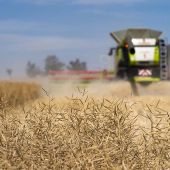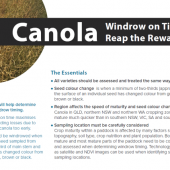Harvest resources
For the nation’s grain growers, harvest is the most critical time of the year.
The culmination of months of carefully managing the crop to optimise yield, a successful harvest is every grower’s priority.
Thorough planning and preparation is the precursor to boosting harvest efficiency and safety, and ultimately the profitability of the farming business.
Over many years, we've invested in research, development and extension (RD&E) to equip growers with knowledge, skills and resources to underpin best practice harvest operations. We continue to invest in harvest-related RD&E that delivers invaluable management recommendations to growers and advisers
The resources below cover all aspects of harvest – preparing crops for harvest, minimising grain loss at harvest, reducing harvester fire risk and farm business considerations.

Maximising canola performance at harvest
Maurie Street, CEO Grain Orana Alliance, talks about windrow timing and direct heading in canola and effects on yield and oil.

Stewardship for pre-harvest application of herbicides in winter crops
The responsibility to avoid herbicide residues in delivered cereal, pulse and oilseed grains sits squarely with grain growers and their advisers.

Early lupin harvest can cut grain losses and optimise quality
Optimum harvest for lupins in WA is at crop maturity when grain moisture levels reach 14 percent. Harvest delays can increase the risks of pod drop, seed shedding, plant lodging, pod shattering and physical damage to seed, which can result in yield losses of 5-20 per cent.

The impact of harvest management in chickpeas
In recent years, chickpeas have transitioned from being generally considered a rotation option between cereal crops to becoming a ‘pillar’ crop of the northern farming system.

Canola – Windrow on time, reap the rewards
This guide will help determine optimal windrow timing.

Reducing the risk of harvester fires
An example of how to set up paddocks and machinery and other measures to reduce the risk of harvester fires.

Reducing harvest fires: the back pocket guide
Harvester fires can not only damage or destroy machinery but can also cause considerable damage to surrounding crops and properties and endanger life.

Tips to avoid harvester fires
Harvester fires can damage equipment, destroy crop and infrastructure and endanger life.

Harvest loss goals as grain percentage
The American Society of Agricultural and Biological Engineers recommend that machine harvest losses should be 1% of grain yield or less for all grains. However, experience by grain growers, ag engineers and proponents of grain loss measuring equipment have found some exceptions to this rule.

Online harvester forum
Online forum full of practical tips, designed to help growers measure and reduce their harvest losses, understand and integrate harvest weed seed control into their system and manage harvester fires.

Minimising canola losses: part 1
A practical demonstration of how much can be lost and how that loss was measured.

Minimising canola losses: part 2
Demonstrates how to measure the volume of grain lost out the back for your header.

Harvest loss calculator
A calculator designed to measure grain loss at harvest using a drop tray that is mounted underneath the harvester.

Time to halve canola harvest losses
One way to harvest more canola and bank more profit is by taking the time to set up the harvester according to crop conditions to minimise the amount of grain falling to the ground.

Weed seed bank destruction - header setup & tips for narrow windrowing
Andrew Messina, (WA grower) explains his experience with cutter bar height, chute design, chute height, crop specific tips.

Chaff lining explained
Peter Newman, from the GRDC-supported Australian Herbicide Resistance Initiative and industry WeedSmart project, explains how to set up for chaff lining at harvest.

Tools and tips: setting up for chaff lining
The chaff lining technique is the cheapest harvest weed seed control tool, both in terms of capital cost and overall cost, including nutrient concentration.

Investigating the harvest weed seed control tools chaff lining and chaff tramlining (chaff deck) in the Esperance area
Grower case studies from the Esperance Port Zone.

Investigating harvest weed seed control tools in low biomass crops in the Kwinana East Zone
Grower case studies from the Kwinana East Port Zone.

Harvest Weed Seed Control for the Southern High Rainfall Zone
HWSC is an important tool to consider for weed management because it is a late-season cultural control tactic. Annual ryegrass is particularly difficult to control in the southern high rainfall zone.

Impact of chaff lining on the seed persistence and emergence of weeds
Burial of weed seeds under chaff can reduce seedling emergence, but the amount of suppression depends on weed type, chaff type, and amount of chaff cover.

Weed control in Australian grain production systems, now and into the future
Harvest weed seed control (HWSC) is an important component of a successful weed management package.

Determining the optimum level of investment in harvest machinery
It is critical to understand the policy that underpins the decision-making process when considering purchasing machinery.

Documenting a contract harvest agreement – what you need to know
A well-constructed contract harvest agreement will minimise the potential areas of contention once harvest begins and when the invoice arrives after completion.

Stored grains website
This website contains information regarding grain storage, including factsheets and booklets.

Mouse control
Mouse management is now a year-round activity.

Tips and tactics: better mouse management
Detecting mice early through monitoring is critical for controlling numbers effectively and reducing crop damage.

Mitigating snails, slugs and slaters in Southern Western Australia
Snails are the most widespread of these pests in Western Australia (WA). They cause damage to grain crops at germination and can potentially cause a costly downgrade of harvested grain if not carefully managed.

Snail identification and control: the back pocket guide
Grain contamination by round and conical snails poses a serious threat to grain exports.

Bash'Em Burn'Em Bait'Em: Integrated snail management in crops and pastures
Grain contamination by round and conical snails poses a serious threat to grain exports. Snails also cause damage to emerging crops and can clog machinery at harvest resulting in delays and frustration.

Snail management fact sheet
Snails cause problems at crop emergence and harvest, integrated management needs to occur across the seasons.

Identification and control of pest slugs and snails for broadacre crops in Western Australia
Numbers of slugs and snails have increased in broadacre cropping in Western Australia with the use of minimum tillage and stubble-retention practices.
Was this page helpful?
YOUR FEEDBACK
